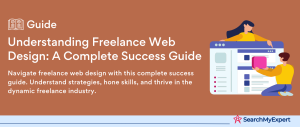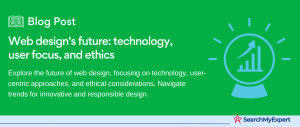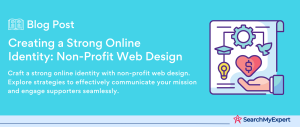The Role of Typography in Web Design
Understanding Typography in Website Design
Typography is an essential element of website design, involving the art and technique of arranging type to make written content legible, readable, and visually appealing. In web design, typography is much more than just selecting fonts; it’s a critical tool for communicating messages and emotions to users.
The influence of typography on website design is multifaceted:
- Creates Atmosphere: The choice of typography sets the tone and feel of a website, significantly impacting the user’s first impression.
- Enhances Readability: Good typography ensures that content is easy to read and understand, contributing to a better user experience.
- Guides Users: Through size, color, and style, typography can guide users’ attention to different parts of a website, highlighting key information.
The Role of Typography in User Experience (UX) and Accessibility
Typography’s role in UX and accessibility is profound:
- Improves UX: Typography that is well-thought-out contributes to a seamless user experience, making information consumption effortless and enjoyable.
- Ensures Accessibility:
Accessible typography, which includes clear fonts and readable sizes, is crucial for users with disabilities. It ensures that everyone, regardless of their abilities, can access and understand the content on a website.
The Anatomy of a Font: Key Components
Understanding the anatomy of a font is crucial for effective typography in web design. Here are the key components:
- Typeface:
A typeface is the overall design of the lettering, a set of characters that share common design features. It’s the unique style of the lettering, like Arial or Times New Roman. - Font Family: This refers to a group of fonts related in design but varying in aspects like weight or style. For example, the Roboto font family includes different styles like Roboto Regular, Roboto Bold, etc.
- Weight:
Font weight indicates the thickness of the characters. Weights can vary from light to bold, significantly affecting the visual impact of the text. - Style:
This involves variations like italic or oblique, which can emphasize or differentiate parts of the text.
Serifs and Sans-Serif Fonts: Impact on Readability
The distinction between serif and sans-serif fonts is a critical aspect of typography:
- Serif Fonts:
These fonts have small lines or strokes attached to the ends of their letters. Examples include Times New Roman and Georgia. Serifs are traditionally seen as more formal and are often used in print media for their readability in long passages of text. - Sans-Serif Fonts: Sans-serif, meaning ‘without serifs,’ are fonts that lack these strokes. Examples include Arial and Helvetica. They offer a cleaner, more modern look and are often easier to read on digital screens, especially at smaller sizes.
The choice between serif and sans-serif fonts affects readability, especially on digital platforms. While serif fonts can be easier on the eyes for long-form content, sans-serif fonts are generally more legible on screens, particularly for shorter, quicker reads.
Choosing the Right Font
Selecting the Perfect Font for Your Website
Choosing the right font for your website is a decision that can significantly influence user engagement and brand perception. Here are key factors to consider:
- Website Purpose:
The font should align with the website’s purpose. For instance, a professional business site might benefit from a clean, sans-serif font, while a creative blog could opt for something more distinctive. - Brand Identity: Fonts carry emotional undertones. A luxury brand might choose an elegant, serif font, while a tech company might prefer a modern, minimalist sans-serif font to reflect its identity.
- Target Audience:
Consider the preferences and expectations of your audience. A younger demographic might resonate with trendy, dynamic fonts, whereas an older audience might prefer traditional, highly legible fonts.
Mastering Font Pairings
Effective font pairings can elevate your website’s design. Here are some tips for creating harmonious combinations:
- Contrast is Key:
Combine fonts that are distinct yet complementary. For example, pairing a serif font for headlines with a sans-serif font for body text can create an engaging contrast. - Limit the Number:
Generally, using two to three fonts is sufficient. Too many fonts can make your site look cluttered and confuse the visual hierarchy. - Consistency Across Weights and Styles:
Ensure that the fonts you pair have a range of weights and styles (like bold, and italic) for flexible use across different types of content. - Test Readability:
Always test your font pairings on different devices and screen sizes to ensure readability and visual appeal.
Hierarchy and Readability
Typography: Creating Information Hierarchy on Webpages
Typography plays a pivotal role in establishing an information hierarchy on a webpage, a crucial aspect of web design that influences how users process information. Here’s how typography achieves this:
- Strategic Use of Font Size: Larger fonts are used for headlines and important titles, instantly drawing attention and indicating their significance. Smaller fonts are typically used for body text, signaling less immediate importance.
- Bold and Italic Styles: These variations are used to emphasize specific text segments, making them stand out and guiding the user’s eye through the content.
- Color and Contrast:
Typography isn’t just about font choice; color and contrast also play significant roles in hierarchy. High-contrast colors for headlines or key phrases can make them pop out against the background.
Impact of Font Size, Line Spacing, and Letter Spacing on Readability
- Font Size:
The size of the text is critical for readability. Too small, and it becomes a strain to read; too large, and it can disrupt the flow of reading. The ideal size balances visibility and readability without overwhelming the user. - Line Spacing (Leading): Line spacing is the vertical distance between lines of text. Proper line spacing prevents text from appearing cluttered, ensuring each line is distinct and easy to follow.
- Letter Spacing (Tracking): This refers to the overall space between characters in a text block. Well-spaced letters improve clarity and readability, especially in digital mediums where screen resolution can affect text appearance.
Typographic Trends and Practices
Current Trends in Web Typography
Web typography is constantly evolving, with new trends emerging that enhance both aesthetics and functionality. Two notable trends are:
- Variable Fonts: These are a new type of font that allows for greater customization. A single variable font file can behave like multiple fonts, offering a range of styles, weights, and widths. This versatility means websites can have rich typographic diversity without the load of multiple font files, improving page load times.
- Micro-Interactions:
Typography is increasingly playing a role in micro-interactions on websites. This involves subtle animations or changes in text when users interact with it, like hovering over a link or button. These interactions enhance user engagement and provide immediate feedback to user actions.
Best Practices for Using Fonts in Web Design
For optimal user experience, consider these best practices:
- Readability is Paramount:
Choose fonts that are easy to read on all devices. This means considering font size, spacing, and color contrast. - Consistency Across the Website: Maintain consistent use of fonts across different pages and sections of your website. This consistency helps in reinforcing brand identity and improving user experience.
- Responsive Typography: Ensure that your typography adjusts well to different screen sizes and resolutions. This includes adjusting font sizes and line spacing for mobile devices.
- Accessibility:
Choose fonts and typographic designs that are accessible to all users, including those with disabilities. Simple, legible fonts and adequate contrast are crucial. - Load Time Considerations:
Be mindful of the impact of fonts on your website’s load time. Opt for web-optimized fonts and consider techniques like font subsetting to improve performance.
Incorporating these current trends and best practices in web typography can significantly enhance the user experience, making your website not only visually appealing but also functional and accessible.
Accessibility Considerations
Emphasizing Accessible Typography in Web Design
Accessible typography is crucial in creating an inclusive digital environment, especially for users with disabilities. Its importance cannot be overstated, as it ensures that content is readable and navigable for everyone, regardless of their visual or cognitive abilities.
Best Practices for Accessible Typography
- Sufficient Contrast:
Text and background colors must have enough contrast to be easily distinguishable. This is vital for users with visual impairments like color blindness. Tools like the WCAG (Web Content Accessibility Guidelines) contrast ratio checker can help in ensuring adequate contrast levels. - Legible Font Size:
Text should be large enough to be read easily by users with vision impairments. Additionally, providing functionality to resize text without breaking the page layout is an excellent practice. - Readable Font Styles:
Choose fonts that are easy to read. Fonts with simple, clear shapes are preferable, as decorative or overly stylized fonts can be difficult to decipher. - Considerate Text Spacing:
Adequate line spacing (leading), paragraph spacing, and letter spacing (tracking) are essential. Proper spacing prevents text from appearing cluttered, aiding users with dyslexia and other reading difficulties. - Responsive Text:
Ensure that text remains legible across different devices and screen sizes. Text that adapts to various screen resolutions and orientations is a must for accessibility. - Avoid Text in Images: When text is embedded in images, screen readers can’t interpret it, making the content inaccessible to users who rely on these assistive technologies.
Tools and Resources
Essential Tools and Resources for Web Typography
For web designers, having the right tools and resources is key to exploring and implementing effective typography. Here are some valuable tools and resources:
- Google Fonts:
A comprehensive library of free fonts, offering a wide range of typefaces suitable for web use. - Adobe Fonts:
Part of the Adobe Creative Cloud, this resource provides a vast selection of high-quality fonts. - Font Pair: A helpful tool for finding complementary font pairings, especially useful for designers looking to create a harmonious typography design.
- WhatTheFont:
This tool allows designers to upload an image and identify the font used, which is particularly useful for inspiration and replication. - Typekit Practice: A learning resource from Adobe that offers practice lessons and resources on typography basics.
- Canva Font Combinations:
A tool that suggests complementary font pairings, making the selection process easier for designers. - A11Y Project: A community-driven resource that provides information and tools to help designers make their websites accessible.
The Future of Typography in Web Design
Looking ahead, the future of typography in web design is set to be influenced by advancements in technology and evolving user needs. Some potential developments include:
- Enhanced Variable Fonts:
With advancements in variable fonts, designers can expect even more flexibility and creativity in typographic designs. - AI-Driven Typography:
Artificial intelligence could play a role in automating aspects of typography, such as optimizing font selection for readability and accessibility based on user data. - Augmented Reality (AR) and Virtual Reality (VR): As these technologies gain traction, we might see new forms of typography designed specifically for immersive environments.
- Greater Focus on Accessibility:
As awareness of the importance of accessibility grows, we can expect more innovations focused on making typography accessible to all users.
Conclusion
Typography in web design is an ever-evolving art that plays a critical role in shaping user experience, brand perception, and website accessibility. From understanding the anatomy of a font to implementing best practices for readability and accessibility, designers have the power to profoundly impact how users interact with and perceive online content.
With the aid of tools like Google Fonts, Adobe Fonts, and resources for creating effective font pairings, designers are well-equipped to make informed typographic decisions. As we look forward to advancements in variable fonts, AI, and immersive technologies like AR and VR, the future of web typography promises even greater possibilities for creative expression and accessibility.
Embracing these changes and staying informed about new trends and practices will be key to creating engaging, inclusive, and visually compelling websites.
Collaborate with creative Web Design Agencies for impactful results.
Table of Contents
Toggle






